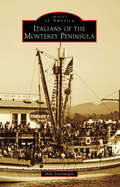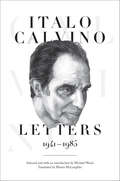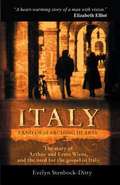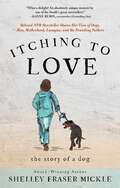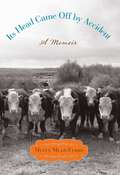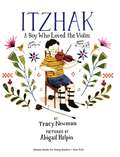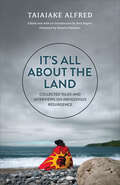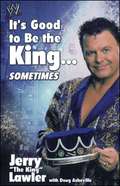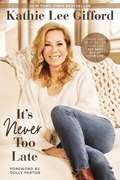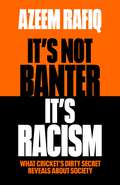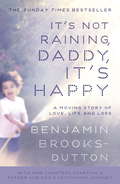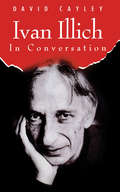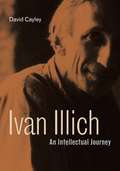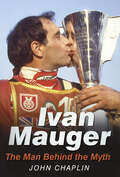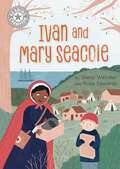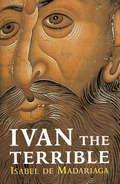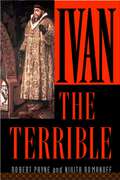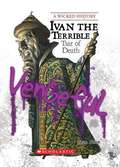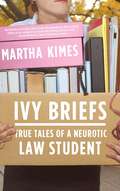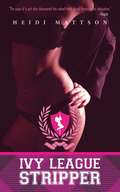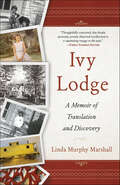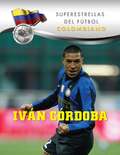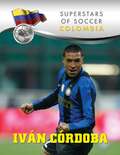- Table View
- List View
Italians of the Monterey Peninsula
by Mike VentimigliaSince the early 1900s, Monterey was known for its fishing, mostly for salmon and the abalone that was plentiful in Monterey Bay. The migration of the Sicilian Italian community is credited for reaping what was called the "Silver Harvest." The Silver Harvest is the name that was given to the fishing of sardines in Monterey, which mostly was done by the Sicilian Italians who established the working fabric in the sardine industry for nearly five decades. Most of that generation is gone, and only a few are memorialized in books. It is this author's attempt to capture the working class that made Monterey the "Sardine Capital of the World."
Italo Calvino: Letters, 1941–1985
by Italo CalvinoThe first collection of letters in English by one of the great writers of the twentieth centuryThis is the first collection in English of the extraordinary letters of one of the great writers of the twentieth century. Italy's most important postwar novelist, Italo Calvino (1923-1985) achieved worldwide fame with such books as Cosmicomics, Invisible Cities, and If on a Winter’s Night a Traveler. But he was also an influential literary critic, an important literary editor, and a masterful letter writer whose correspondents included Umberto Eco, Primo Levi, Gore Vidal, Leonardo Sciascia, Natalia Ginzburg, Michelangelo Antonioni, Pier Paolo Pasolini, and Luciano Berio. This book includes a generous selection of about 650 letters, written between World War II and the end of Calvino’s life. Selected and introduced by Michael Wood, the letters are expertly rendered into English and annotated by well-known Calvino translator Martin McLaughlin.The letters are filled with insights about Calvino’s writing and that of others; about Italian, American, English, and French literature; about literary criticism and literature in general; and about culture and politics. The book also provides a kind of autobiography, documenting Calvino’s Communism and his resignation from the party in 1957, his eye-opening trip to the United States in 1959-60, his move to Paris (where he lived from 1967 to 1980), and his trip to his birthplace in Cuba (where he met Che Guevara). Some lengthy letters amount almost to critical essays, while one is an appropriately brief defense of brevity, and there is an even shorter, reassuring note to his parents written on a scrap of paper while he and his brother were in hiding during the antifascist Resistance.This is a book that will fascinate and delight Calvino fans and anyone else interested in a remarkable portrait of a great writer at work.
Italy, Land of Searching Hearts: The Story of Arthur and Emma Wiens, and the Need for the Gospel in Italy
by Evelyn Stenbock-DittyA True Story from the forgotten mission field of Europe. "Italy is one of the most neglected mission fields in all Europe. Art Wiens has had a lifetime of service there and he is one of my heroes." George Verwer, Operation Mobilisation. "Art and Erma Wiens are the true prototype of those who have led the way in missionary work in Europe... will help in the understanding of the challenge of Europe as a mission field."
Itching to Love
by Shelley MickleA beloved NPR storyteller and award-winning author discovers life after kids when a neighbor's dog steals her things--and her heart--in this hilarious and uplifting memoir.In this hilarious memoir, award-winning author Shelley Fraser Mickle takes readers on a humorous yet heartwarming and intimate journey into a slice of her life. Itching to Love gives readers not only laughs but also a realization that their own lives are a singular magnificence enhanced by unexpected detours. Shelley shares how a woman discovers her neighbor&’s dog has been stealing her things and stashing them next to his food bowl and forcing her to ponder, What did he see in her that she did not see in herself? Never in her wildest dreams would she have predicted that she would fall in love with a dog with yellow snake eyes who refuses to let her be owned by anyone else. In this short memoir you will find yourself smiling, laughing, and crying as Shelley introduces you to astronauts, Founding Fathers, family members we can all relate to, along with many others who educated her heart. And, of course, Buddy the ordinary dog who sensed she was secretly harboring an unrecognized sorrow. When her second novel Replacing Dad was translated into film, one reviewer said it was the funniest story since Auntie Mame. Yes, Shelley is indeed funny, which is why NPR in Washington D.C. called one day to ask her to tell her stories on Morning Edition, which she did for six years.
Its Head Came Off by Accident: A Memoir
by Muffy Mead-FerroIts Head Came Off by Accident is a humorous, yet poignant reflection on gratitude and loss. It describes a childhood that takes place on a vast Wyoming landscape--more than 6,000 acres near near Jackson Hole and adjacent to Grand Teton National Park--where the author grew up with adventure-crazed, raucous brothers and friends, and a colorful collection of Western characters, most particularly her own mother. Mead-Ferro's desire to move back to her childhood homeland from the city is weighed with how she felt when she did live on the cattle ranch, always unsure if she fit in. When Mead-Ferro's mother is killed in a freak horse accident while herding cattle, Mead-Ferro faces the loss not only of this profoundly influential person but of the entire ranching operation: a century-old legacy. After she and her brothers sell the family ranch Mead-Ferro attempts to recreate the landscape of her childhood--particularly the privileges and responsibilities of land, animals, and real work--as a bequest to her own children.
Itzhak A Boy Who Loved the Violin: A Boy Who Loved The Violin
by Tracy NewmanItzhak Perlman was infected with polio at the age of four and despite this he went on to become an acclaimed violinist.
It’s All about the Land: Collected Talks and Interviews on Indigenous Resurgence
by Taiaiake AlfredIlluminating the First Nations struggles against the Canadian state, It’s All about the Land exposes how racism underpins and shapes Indigenous-settler relationships. Renowned Kahnawà:ke Mohawk activist and scholar Taiaiake Alfred explains how the Canadian government’s reconciliation agenda is a new form of colonization that is guaranteed to fail. Bringing together Alfred’s speeches and interviews from over the past two decades, the book shows that Indigenous peoples across the world face a stark choice: reconnect with their authentic cultures and values or continue following a slow road to annihilation. Rooted in ancestral spirit, knowledge, and law, It’s All about the Land presents a passionate argument for Indigenous Resurgence as the pathway toward justice for Indigenous peoples.
It’s Good to Be the King... Sometimes
by Jerry "The King" LawlerJerry Lawler is hailed as one of sports-entertainment's most enduring and colorful characters. His life has been filled with hilarious, never-been-told stories... until now! His reign consists of thirteen championships (one of which he's held more than forty times), three marriages, and two children. He's dominated Memphis radio and television airwaves. Starred in feature films. Recorded albums. Tolerated countless sprains, broken bones, concussions, and contusions. The way Jerry "The King" Lawler tells it, if you're good at something, do it more than once. It's Good To Be The King... Sometimes is a no-holds-barred personal account from the "puppies"-pantin' King of one-liners, who steps out from behind the announcer's desk of WWE Raw to hold court about everything. His passion for art that first drew him to the ring of a rundown West Memphis movie theater over thirty years ago. The comic adventures and tragic bumps endured journeying down the "Music Highway" of Interstate 40 with the National Wrestling Alliance. Earning his royal personage in the Bluff City of the Mighty Mississippi against his own mentor, "Fabulous" Jackie Fargo. Grappling with mat legends Ric Flair, Lou Thesz, Jesse Ventura, Andre the Giant, Terry Funk, and Bret "Hitman" Hart. And his crowning achievements as co-ruler of the United States Wrestling Association, which contributed to the rise of future WWE Superstars Hulk Hogan, Undertaker, Stone Cold Steve Austin, and The Rock. It's time you lackeys pay heed as the King reveals the schemes and outrageous story lines to many of wrestling's most fantastic theatrics and all-too-real moments. Lawler tells of his legendary "feud" with Andy Kaufman, and his much-publicized confrontation with the actor portraying the late comedian on the set of Man on the Moon,and the "Karate-versus-Wrestling" match that almost occurred between Lawler and Memphis's other King. And be sure to honor his royal proclamations regarding former wives, and his mother's opinion of wrestling; why he once sued future boss Vince McMahon... and won; and the body part he truly worships on a WWE Diva.
It’s Never Too Late: Make the Next Act of Your Life the Best Act of Your Life
by Kathie Lee GiffordFormer Today show host Kathie Lee Gifford draws on stories from her remarkable life to weave together a beautiful reminder that whatever circumstances we face, God is still dreaming big for our years ahead. When Kathie Lee Gifford stepped down as cohost of the fourth hour of the Today show with Hoda Kotb, you might have thought her best days were behind her. It turns out, she was just getting started. As Kathie Lee says, &“I&’m not retiring; I&’m refiring!&” Taking us from her Chesapeake Bay childhood when she first heard God&’s calling, to her skyrocketing fame with Regis, to her decision to leave television for Nashville, Kathie Lee inspires us to pursue what really matters. Because it&’s never too late to forgive, to dance the cha-cha, or to make a difference in the world. God placed His dreams in your heart for a reason. And like Kathie Lee, you might just discover that the best is yet to come. Whether you&’re an empty nester, newly single, navigating a career change, or just eager for any change, Kathie Lee helps you hear God&’s loving calling because It&’s Never Too Late to . . .Begin AgainMake Sparks FlyLeave a Good ThingHave a PartyChange the Ending, Then Change It AgainIs it time for you to rewrite your story, unearth your hidden passions, and live with a renewed purpose? It&’s never too late.
It’s Not Banter, It’s Racism: What Cricket’s Dirty Secret Reveals About Our Society
by Azeem RafiqTHE STORY OF ONE MAN WHO CHANGED THE FACE OF CRICKET FOREVER.'Azeem's first legacy - a legacy carved at great personal expense - was to expose how cricket works. His second gift may be to expose how this country works, too.' Jonathan LiewWhen Azeem Rafiq was a young boy playing cricket near his home in Pakistan, he could never have foreseen that this sport would change his life forever. He fell in love with the game quickly and it wasn't long before the white flannels and green grass felt like home to him. When he moved to England, he became the youngest man to captain a Yorkshire side and the first person of Asian descent to do so. His talent was undeniable, and doors were opening for him.But there was something Azeem was bottling up and it was about to explode out of him and shake the whole cricket world, and wider society, out of their slumber. It's Not Banter, It's Racism is the never before-told truth behind the racism accusations that shocked a nation, from the moment Azeem spoke up to the resulting events that have altered his world entirely. With heartbreaking honesty, Azeem reveals why he will always use his voice in a society that would prefer him to be voiceless.'Azeem has stood up to the world, spoken back against evil. He has had victories. He has failed. He extends charity to others and he says no: no to racism. Because we must be better than our worst.' Stan Grant'Azeem's dream was to help England win the Ashes. That wasn't to be. But maybe, one day we'll reflect that his legacy to the game is far greater than winning any amount of Test series.' George Dobell'A principled whistleblower who stood up for what was right, Azeem has changed cricket forever.' Jennifer Robinson'Honest, open and powerful.' Baroness Warsi
It’s Not Banter, It’s Racism: What Cricket’s Dirty Secret Reveals About Our Society
by Azeem RafiqTHE STORY OF ONE MAN WHO CHANGED THE FACE OF CRICKET FOREVER.'Azeem's first legacy - a legacy carved at great personal expense - was to expose how cricket works. His second gift may be to expose how this country works, too.' Jonathan LiewWhen Azeem Rafiq was a young boy playing cricket near his home in Pakistan, he could never have foreseen that this sport would change his life forever. He fell in love with the game quickly and it wasn't long before the white flannels and green grass felt like home to him. When he moved to England, he became the youngest man to captain a Yorkshire side and the first person of Asian descent to do so. His talent was undeniable, and doors were opening for him.But there was something Azeem was bottling up and it was about to explode out of him and shake the whole cricket world, and wider society, out of their slumber. It's Not Banter, It's Racism is the never before-told truth behind the racism accusations that shocked a nation, from the moment Azeem spoke up to the resulting events that have altered his world entirely. With heartbreaking honesty, Azeem reveals why he will always use his voice in a society that would prefer him to be voiceless.'Azeem has stood up to the world, spoken back against evil. He has had victories. He has failed. He extends charity to others and he says no: no to racism. Because we must be better than our worst.' Stan Grant'Azeem's dream was to help England win the Ashes. That wasn't to be. But maybe, one day we'll reflect that his legacy to the game is far greater than winning any amount of Test series.' George Dobell'A principled whistleblower who stood up for what was right, Azeem has changed cricket forever.' Jennifer Robinson'Honest, open and powerful.' Baroness Warsi
It’s Not Raining, Daddy, It's Happy
by Benjamin Brooks-DuttonThe Sunday Times bestsellerThe moving and inspiring account of heartbreak and courage, and the life-affirming relationship between a father and son. Ben Brooks-Dutton's wife - the great love of his life - was knocked down and killed by a car as he walked beside her, pushing their two-year-old son in his buggy. Life changed forever. Suddenly Ben was a widower deep in shock, left to raise their bewildered child alone. In the aftermath Ben searched for guidance from men in similar situations, but it appeared that young widowed fathers don't talk. Well meaning loved ones admired his strength. The unwritten rule seemed to be to 'shut up, man up and hide your pain'. Lost, broken and afraid of the future, two months after his wife Desreen's death, Ben started a blog with the aim of rejecting outdated conventions of grief and instead opening up about his experiences. Within months Life as a Widower, had received a million hits and had started an all-too-often hushed conversation about the reality of loss and grief. This is the story of a man and a child who lost the woman they so dearly love and what happened in the year that followed. Ben describes the conflicting emotions that come from facing grief head on. He rages against the clichés used around loss and shows the strange and cruel ways in which grief can take hold. He also charts what it means to become a sole parent to a child who has lost their mother and cannot yet understand the meaning of death. Through the shock and sadness shine moments of hope and insight. So much of what Ben learns comes from watching his son struggle, survive and live, as children do, from moment to moment where hurt can turn to happiness and anger can turn to joy. This is a story of loss, heartbreak and courage. At its heart is the funny, infuriating and life affirming relationship between a father and son and their ongoing love for an extraordinary woman.
Ivan Illich in Conversation: The Testament of Ivan Illich
by David CayleyFor more than fifteen years, iconoclastic thinker Ivan Illich refused to be interviewed. Finally, in 1988, CBC's David Cayley persuaded Illich to record a conversation. This first interview led to additional sessoins that continued until 1992 and are now gathered in Ivan Illich in Conversation. In these fascinating conversations, which range over a wide selection of the celebrated thinker's published work and public career, Illich's brilliant mind alights on topics of great contemporary interest, including education, history, language, politics, and the church.
Ivan Illich: An Intellectual Journey (Ivan Illich #2)
by David CayleyIn the eighteen years since Ivan Illich’s death, David Cayley has been reflecting on the meaning of his friend and teacher’s life and work. Now, in Ivan Illich: An Intellectual Journey, he presents Illich’s body of thought, locating it in its own time and retrieving its relevance for ours.Ivan Illich (1926–2002) was a revolutionary figure in the Roman Catholic Church and in the wider field of cultural criticism that began to take shape in the 1960s. His advocacy of a new, de-clericalized church and his opposition to American missionary programs in Latin America, which he saw as reactionary and imperialist, brought him into conflict with the Vatican and led him to withdraw from direct service to the church in 1969. His institutional critiques of the 1970s, from Deschooling Society to Medical Nemesis, promoted what he called institutional or cultural revolution. The last twenty years of his life were occupied with developing his theory of modernity as an extension of church history. Ranging over every phase of Illich’s career and meditating on each of his books, Cayley finds Illich to be as relevant today as ever and more likely to be understood, now that the many convergent crises he foresaw are in full public view and the church that rejected him is paralyzed in its “folkloric” shell.Not a conventional biography, though attentive to how Illich lived, Cayley’s book is “continuing a conversation” with Illich that will engage anyone who is interested in theology, philosophy, history, and the Catholic Church.
Ivan Illich: An Intellectual Journey (Ivan Illich: 21st-Century Perspectives #2)
by David CayleyIn the eighteen years since Ivan Illich’s death, David Cayley has been reflecting on the meaning of his friend and teacher’s life and work. Now, in Ivan Illich: An Intellectual Journey, he presents Illich’s body of thought, locating it in its own time and retrieving its relevance for ours.Ivan Illich (1926–2002) was a revolutionary figure in the Roman Catholic Church and in the wider field of cultural criticism that began to take shape in the 1960s. His advocacy of a new, de-clericalized church and his opposition to American missionary programs in Latin America, which he saw as reactionary and imperialist, brought him into conflict with the Vatican and led him to withdraw from direct service to the church in 1969. His institutional critiques of the 1970s, from Deschooling Society to Medical Nemesis, promoted what he called institutional or cultural revolution. The last twenty years of his life were occupied with developing his theory of modernity as an extension of church history. Ranging over every phase of Illich’s career and meditating on each of his books, Cayley finds Illich to be as relevant today as ever and more likely to be understood, now that the many convergent crises he foresaw are in full public view and the church that rejected him is paralyzed in its "folkloric" shell.Not a conventional biography, though attentive to how Illich lived, Cayley’s book is "continuing a conversation" with Illich that will engage anyone who is interested in theology, philosophy, history, and the Catholic Church.
Ivan Mauger: The Man Behind the Myth
by John ChaplinThis is the first book to the reveal the complex personality behind the public image that is Ivan Mauger, the dedicated and often ruthlessly efficient speedway multi- World Champion. Driven by uncompromising determination and naked ambition he became, to terrace fans and on-track rivlas alike, a virtual sporting automaton. His motorcycle racing achievements - 15 world titles on speedway and long track - are testament to his pursuit of excellence. He elevated a minority sport to a new and higher dimension with professionalism that made him at once envied and feared, admired and hated. And it launched him from the obscurity of his small-town New Zealand origins to worldwide acclaim, which continues to enjoy. Here, renowned speedway historian and journalist John Chaplin reveals, through the words of opponents, friends, enemies, business associated, fans, rivals and his own family, the real Ivan Mauger...the man behind the myth.
Ivan and Mary Seacole: Independent Reading White 10 (Reading Champion #517)
by Sheryl WebsterThis story is part of Reading Champion, a series carefully linked to book bands to encourage independent reading skills, developed with Dr Sue Bodman and Glen Franklin of UCL Institute of Education (IOE) Fantastic, original stories are accompanied by engaging artwork and a reading activity. Each book has been carefully graded so that it can be matched to a child's reading ability, encouraging reading for pleasure. Perfect for 5-7 year olds or those reading book band white.
Ivan the Terrible
by Isabel de Madariaga&“This significant biography of the 16th-century Russian czar…is likely to become the definitive work on Ivan for some time&” (Publishers Weekly, starred review). One of the most important figures in Russian history, Ivan IV Vasilyevich has remained among the most neglected. The country&’s first Tsar, he is notorious for pioneering a policy of unrestrained terror—and for killing his own son. In Ivan the Terrible, Russian historian Isabel de Madariaga presents the first comprehensive biography of Ivan from birth to death, shedding light on his policies, his marriages, his atrocities, and his disordered personality. Situating Ivan within the Russian political developments of the sixteenth century, de Madariaga also offers revealing comparisons with English, Spanish, and other European courts of the time. The biography includes a new account of the role of astrology and magic at Ivan&’s court and provides fresh insights into his foreign policy. Addressing the controversies that have paralyzed western scholarship as well as the challenges of authentication—since much of Ivan&’s archive was destroyed by fire in 1626—de Madariaga seeks to present Russia as viewed from within Russia rather than from abroad. The result is an enlightening work that captures the full tragedy of Ivan&’s reign.
Ivan the Terrible
by Robert Payne Nikita RomanoffCzar Ivan IV (1530-1584), the first Russian ruler to take the title czar, is known as one of the worst tyrants in history, but few people among the general public know how he got such an infamous reputation. Relying on extensive research based heavily on original Russian sources, this definitive biography depicts an incredibly complex man living in a time of simple, harsh realities. Robert Payne, the distinguished author of many historical and biographical works, and Russian scholar Nikita Romanoff, describe in vivid and lively detail Ivan's callous upbringing; the poisoning of his second wife and the murder of his son; his obsession with religion and sin; his predilection for mass murder, evidenced by his massacre of 30,000 citizens of Novgorod; yet his remarkable intelligence as a ruler, supporting the growth of trade and expanding Russia's borders.
Ivan the Terrible: Tsar of Death
by Sean PriceAs Russia's first tsar, this ruthless ruler forced thousands from their homes, tortured spies, executed enemies, and even killed his own son. Will anyone ever really know what made Ivan so terrible?
Ivy Briefs: True Tales of a Neurotic Law Student
by Martha KimesFrom first-day nerves to first-year grades, from bizarre job interviews to bar exam insanity, Ivy Briefs pulls back the curtain on the marbled halls of law school, revealing the absurdity often bubbling beneath the surface. Meet Martha Kimes: a naïve small-town girl with strong neurotic tendencies who has (due to an inexplicable stroke of luck) been admitted to Columbia Law School. She's a Midwesterner in the middle of Manhattan, a student on the verge of a nervous breakdown. In her candid memoir -- the best of its kind since One L and the only one written by a woman -- Kimes makes her way through law school, doing battle with a memorable cast of characters: The Sadistic Professor: Every law student's nemesis, the Sadistic Professor takes pity on no one. The Socratic Method is his favorite torture device, and he's got staying power that rivals that of the Energizer Bunny. The Gunner: So enamored with the sound of his own voice, he finds it physically impossible to keep his hand from gunning up into the air every time a professor asks a question. Ten minutes into the start of the school year, everyone is already sick of the Gunner. The Do-gooder: Lurking behind a kind exterior is a pit bull ready to pounce on those who don't plan to devote their legal careers to public service. But would she be so quick to categorize all those who dare go into corporate law as loathsome, soulless warriors for the devil if she, too, had student loans to repay? The Boarding School Bastard: He wears a firmly pressed pin-striped oxford shirt and has a condescending attitude bigger than most European countries. By definition he is better than you because he went to Exeter. And he'll never let you forget it. With sharp wit, dead-on aim, and a healthy dose of self-deprecation, Kimes proves that it is possible to survive law school with both your sense of humor and your sanity intact.
Ivy League Stripper: A Memoir
by Heidi MattsonHeidi Mattson successfully united sex and scholarship to realize a '90s version of the American Dream by becoming a smart, sassy, self-confident stripper while attending Brown University in Providence, Rhode Island. Intelligent and ambitious, she grew up
Ivy Lodge: A Memoir of Translation and Discovery
by Linda Murphy MarshallAfter both her parents die, Linda Murphy Marshall, a multi-linguist and professional translator, returns to her midwestern childhood home, Ivy Lodge, to sort through a lifetime of belongings with her siblings. Room by room, she sifts through the objects in her parents’ house and uses her skills and perspective as a longtime professional translator to make sense of the events of her past—to “translate” her memories and her life. In the process, she sees things with new eyes. All of her parents’ things, everything having to do with their cherished hobbies, are housed in a home that, although it looks impressive from the outside, is anything but impressive inside; in short, she now realizes that much of it —even the house’s fancy name—was show. By the time Murphy Marshall is done with Ivy Lodge, she has not only made new discoveries about her past, she has also come to a new understanding of who she is and how she fits into her world.
Iván Córdoba (Superstars of Soccer SPANISH)
by Gustavo VazquezIván Ramiro Córdoba se elevó desde orígenes humildes. Nacido en una familia pobre, creció jugando al fútbol en las calles de Rionegro, Colombia. Después de un par de años con el equipo local de Rionegro, se trasladó al club Atlético Nacional de Medellín. Luego jugó para San Lorenzo, un club basado en Buenos Aires. Su habilidad a desarmar a los ataques de los oponentes más pronto llamó la atención de clubes europeos, y en 1999 fue al Inter de Milán. En una docena de años con el Inter de Milán, Córdoba se ganó una reputación como uno de los mejores defensores del mundo. él ayudó al club a un par de campeonatos de la liga. Para los colombianos, sin embargo, Córdoba siempre será recordado por un gol que marcó el 29 de julio de 2001. Ese gol dio a Colombia el campeonato de la Copa América.
Iván Córdoba (Superstars of Soccer)
by Gustavo VazquezIván Ramiro Córdoba se elevó desde orígenes humildes. Nacido en una familia pobre, creció jugando al fútbol en las calles de Rionegro, Colombia. Después de un par de años con el equipo local de Rionegro, se trasladó al club Atlético Nacional de Medellín. Luego jugó para San Lorenzo, un club basado en Buenos Aires. Su habilidad a desarmar a los ataques de los oponentes más pronto llamó la atención de clubes europeos, y en 1999 fue al Inter de Milán. En una docena de años con el Inter de Milán, Córdoba se ganó una reputación como uno de los mejores defensores del mundo. él ayudó al club a un par de campeonatos de la liga. Para los colombianos, sin embargo, Córdoba siempre será recordado por un gol que marcó el 29 de julio de 2001. Ese gol dio a Colombia el campeonato de la Copa América.
